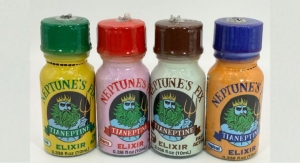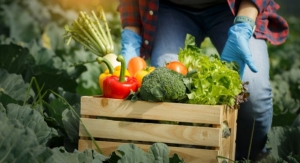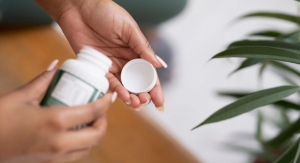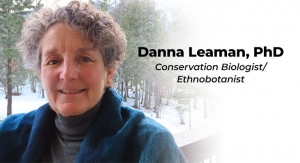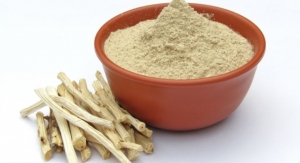Julie Dennis, Contributing Writer07.01.13
International botanical sales have been experiencing steady growth for many years. In fact, the international herb supplement market is projected to reach $93 billion by 2015, according to Global Industry Analysts, Inc., San Jose CA.
While there are a myriad of reasons for this continued rise in popularity, there are several overarching themes worldwide. One reason is cost savings.
For example, in the U.S. a substantial 81% of shoppers are trying to save on medical expenses by staying healthy, according to a report published by IRI, Chicago, IL.
“Consumers continue to try to take more control of their health,” said Barbara Davis, PhD, RD, director of medical and scientific affairs at PL Thomas & Co, Inc., Morristown, NJ. Consumers are becoming “more knowledgeable about nutrition and health and are making decisions about how to manage health issues themselves—all signs of control. Dietary supplements, including vitamins and minerals as well as herbals and botanicals, fit this need,” she added.
With more people using natural remedies it’s not surprising that in 2012 alone pharmaceutical giant Pfizer bought Alacer Corp., (makers of Emergen-C), Procter & Gamble acquired New Chapter Inc. and Reckitt Benckiser outbid Bayer to purchase Schiff Nutrition International Inc.
Another theme driving the global botanicals market is tradition. Humans have been consuming botanicals for medicinal and culinary purposes for centuries. As noted by the World Health Organization (WHO), traditional medicine has been with the organization, “for the last twelve years or so and for the rest of the world for the last several thousand years of recorded history.”
“Botanicals have always played a key role in human history as traditional remedies,” said Sébastien Bornet, director of global marketing, Horphag Research, exclusive worldwide supplier of Pycnogenol French maritime pine bark extract. “Thousands of years ago, ancient civilizations in Europe, China, India, Japan, Middle East and other regions already knew about the healing power of Mother Nature, and considered plants as an infinite source of solutions to their health problems. More recently, consumers have shown a growing interest for natural health solutions, and for botanicals in particular.”
Also continuing to drive sales worldwide is the sizeable number of seniors who are increasingly incorporating botanicals into their health protocols. In fact, the number of older people is growing faster than any other age group, and two people celebrate their 60th birthday every second, according to a report by the United Nations Population Fund Report. The report also noted that the over-60 market is expected to reach nearly 2 billion by 2050.
There is also growing concern among consumers about how the daily use of synthetic products and chemical compounds may impact their health long-term, according to Mr. Bornet. “People tend to pay more attention to the origin of the products they buy, and want to know whether it is natural or not. They don’t act this way because it is a ‘trendy’ lifestyle, but because they want to live better, longer and healthier.”
Consumers are also more proactive about becoming better educated on health issues, he added. “It is very likely a product will be ‘Googled’ before it is purchased. Consumers want to know what is behind the ad, the label or the sales pitches. Social media, blogs, forums and other information sources on the Internet offer new and unique opportunities to everyone willing to check if a product is safe, efficient and manufactured according to the highest quality standards.”
Although interest in botanicals continues to rise, supply may not always be able to keep up with growing demand. First off, as quality requirements become increasingly stringent in countries worldwide, ingredients that used to be acceptable are no longer meeting higher standards. Also, changing weather patterns have made some crop yields unpredictable.
“The challenges for supply are varied but a steep rise in demand can make it difficult to provide a consistent, quality supply of botanical materials,” said Eden Somberg, technical specialist, Health Business Unit, Frutarom, Ltd. “Changes in weather and climate can have a huge impact on the growing season for many plants and therefore create supply problems as well.”
And although most buyers and sellers are doing the right thing, with an abundance of customers and periodic shortages of supply, economically motivated adulteration may periodically result. In response, many organizations worldwide are coalescing and implementing measures to help address this problem.
In the U.S., the American Botanical Council, the American Herbal Pharmacopoeia and the University of Mississippi’s National Center for Natural Products Research launched a comprehensive program to educate herbal and dietary supplement industry members about ingredient and product adulteration.
Although botanicals continue to increase in popularity, as with all industries, ebbs and flows should be expected. But regardless of any fluctuations, the drivers will remain consistent for some time: aging populations with a desire to save money and support their health proactively by incorporating natural solutions. Botanicals are part of this equation.
United States
With an estimated 26% of the market share, the U.S. is the largest consumer of natural products and continues to grow at a healthy rate. Double-digit growth was reported within the natural channel markets every four-week period throughout 2012, according to SPINSscan data.
U.S. sales of vitamins, minerals and supplements are growing 5-7% annually, and totaled nearly $23 billion in 2012, according to Euromonitor International. And a sizeable 23% of these U.S. consumers are using botanicals, according to the Council for Responsible Nutrition (CRN), Washington D.C., 2011 Survey.
Best-selling dietary supplement categories in the natural channel included weight loss with the highest growth of 43%, according to SPINSscan data for the 52-week period ending Jun. 9, 2012. Other top-selling categories included pre-natal support, energy, hair, skin and nails, sleep, intimacy products, digestion, liver support, menopause, cognitive health, pain, inflammation and mood support, according to the report.
In the single herb category, best-sellers included kava, milk thistle, elderberry and Echinacea, according to SPINSscan data for the 52-week period ending Mar. 16, 2013. Turmeric, which combines a long history of safe usage with years of supporting research while addressing common health concerns, took the number one best-selling spot. In fact, to help quench thirst for this popular herb, India exported an estimated 70 million kilograms of turmeric between 2010-2011.
It’s also no surprise to see stevia on the top-sellers list, considering the fact that Americans are the heaviest consumers of sweeteners in the world, according to a report from Packaged Facts, Rockville, MD. After the U.S. FDA approved stevia’s usage as a sweetener in 2008 its rise was swift. In 2012, stevia-based Truvia, (from Cargill, Minneapolis, MN), became the second best-selling brand of sugar substitute, second only to Splenda, according to a report by IRI.
While the audience for botanicals continues to grow, the FTC and FDA continue to enforce and refine regulations, including the current Good Manufacturing Practices (cGMPs) and a forthcoming rewrite of the New Dietary Ingredient guidance.
As of June 2010, all manufacturers were supposed to be compliant with the cGMPs issued by FDA in 2007. Since implementation, the agency has actively pursued non-compliant manufacturers with warning letters and closures.
European Union
Botanicals are no stranger to the people in regions throughout the EU. In fact, herbal medicines have been available in the U.K. for more than 40 years as prescription or over-the-counter medications.
And similar to many regions across the globe, regulations in the EU continue to be enforced and refined. Herbal medicines are now required to hold Traditional Herbal Registration granted on the basis of 30 years of safe use, with 15 of those years in Europe, as well as passing stringent quality tests.
Since May of 2011, approximately 350 herbal medicinal products have been approved for marketing, according to the American Botanical Council’s (ABC) HerbalEGram (Vol. 9, No. 6, June 2012).
Last year, the first Traditional Chinese Medicine (TCM) was granted registration. The product, Diao Xin Xue Kang, is from Japanese yam root (Dioscorea nipponica) and is used to treat myocardial ischemia. The product was developed by the Di’ao Pharmaceutical Group (DPG) in China and the Chengdu Institute of Biology at the Chinese Academy of Sciences. According to DPG President Li Bogang, it took approximately six years to bring this product to market in Europe, including two years of research on the active chemical constituents, as noted in the ABC HerbalEGram.
Beginning in 2006, allowable health claims in the EU were being reviewed and revised, and were released just last year. While ingredient labeling is now allowed with 222 health claims approved, mostly for vitamins and minerals, health claims for botanicals have yet to be released.
While increases are expected to continue in the more mature markets like the U.S. and Western Europe, as with many industries, it is the emerging markets, including Brazil, Russia, India and China that are experiencing the fastest growth.
India
The world’s largest democracy, with an estimated 1.2 billion people, India will go from being the world’s 10th largest economy in 2011, to become the fifth largest by 2020, according to the Centre for Economics and Business Research, Washington, D.C.
As the economy expands, so does interest in botanical supplements. The Ayurvedic market in India, which relies heavily on herbs, was $2 billion in 2010, and is expected to reach $5 billion by 2015, according to estimates published in Nutrition Business Journal, Boulder, CO. By comparison, the U.S. Ayurvedic market was an estimated $30 million in 2010.
Of course, botanicals have been used medicinally for centuries in India, but the dietary supplements market is relatively new. To help regulate this burgeoning industry, the Foods Safety and Standards Act was introduced in 2006. And although the regulations are not yet implemented, for the first time in India’s history this law recognizes the terms “nutraceutical” and “functional food.”
These new categories may eventually be classified as foods similar to the U.S. regulations wherein supplements cannot claim to treat, cure or mitigate disease except for certain permitted health claims.
India also has a sweet tooth. For example, India is the fastest-growing market globally for chocolate, posting the largest increase in sales with 21% growth between 2008 and 2011, according to Mintel Group. It is estimated that by 2025 one out of two diabetics in the world will be Indian. Therefore, botanicals addressing diabetes, blood glucose balance and cholesterol will likely continue to increase in popularity, as will botanicals addressing the health concerns of an increasingly urbanized and industrialized nation.
While botanicals have been used for centuries in India, many questions remain for the nation’s emerging botanical supplement market. Specifically, how will Indian regulations reconcile modern, corporate research with ancient traditions, and when will the regulations introduced in 2006 be implemented.
China
Approximately 1.3 billion people in China are fueling the estimated $11-20 billion dietary supplements market, which represents approximately 15% of the world’s overall nutrition market. Projected revenue of TCM supplements, which also rely heavily on botanicals, will generate an estimated $430 million in 2012.
And although the economy is showing signs of slowing, it is projected that by 2020 China will evolve into the largest global producer and consumer of nutraceutical ingredients, surpassing the U.S. and Western Europe, according to The Freedonia Group, Cleveland, OH.
Drivers in China’s botanical market are similar to what many other regions around the world are experiencing. Approximately 13% of the population is over 60, incomes are rising, and between SARS, avian flu and a string of tainted products, many are seeking comprehensive support to help maintain health. Therefore, with its long history of botanical medicine it’s not a far stretch for many people in China to begin, or increase, usage of botanical medicine.
Dietary supplement regulations in China are considered “some of strictest in the world,” according to Jeff Crowther, executive director at the U.S.-China Health Products Association (USCHPA).
Meeting regulatory requirements is costly (upward of $50,000 per SKU to introduce a new dietary supplement), lengthy, complex and potentially inconsistent, according to a USCHPA report. And although many businesses are tempted to jump into the Chinese foray, the whole process may be confusing and frustrating. “The entire system needs an overhaul and everyone knows it,” Mr. Crowther wrote in an article on the Chinese market for Nutraceuticals World in November 2012.
Despite potential roadblocks, foreign businesses continue investing in China. For example, Amway recently invested approximately $95 million in a new manufacturing facility in China, and a subsidiary of NBTY opened its first health food store in Shanghai. GNC is expanding distribution around the country and Vitamin Store, a Dutch health food store chain, opened its first store in Xiamen with plans to expand, according to Mr. Crowther.
Not only is China a huge consumer of botanicals, it is also a huge supplier. And for many years China has been able to keep botanical prices low, but the times are changing. In fact, raw material costs have doubled recently for 84% of ingredients used in 537 traditional Chinese medicines, according to the Association of Traditional Chinese Medicine, London, England. Contributing factors include flooding, drought, increasing labor costs, industry growth and market speculation, according to the Shanghai Daily News, June 2011.
Mexico, Central & South America
Latin America also has a long and rich history of botanical usage and for years dietary supplements have been gaining ground as well. This growing interest in supplements is nothing new for the region. In fact, Mexico and South & Central America are Herbalife’s third and fourth largest markets, totaling an estimated $1.3 billion in 2011 sales, 32% of the company’s total global revenue. (In the first quarter of 2013, South and Central America grew 33%, according to Michael Johnson, Herbalife’s chairman and CEO.)
“The trend across the globe, including Latin America, is toward more rather than less regulation, more demanding legislation and a greater need for high quality, scientific, technical, regulatory guidance to decision-makers,” according to David Pineda, regulatory affairs director, International Alliance of Dietary/Food Supplement Associations (IADSA).
The newly formed (2011) Latin American Responsible Nutrition Alliance (ALANUR) is helping harmonize legislation between diverse countries including Mexico, Colombia, Peru, Brazil and Argentina. Herbalife, Omnilife, DSM and Amway helped form ALANUR. The effort needed to coalesce and standardize regulations among the varied countries involved is immense and will likely be lengthy.
“The aim of ALANUR is to ensure a clear and enforced regulatory framework for food supplements covering a broad range of safe ingredients, appropriate globally recognized manufacturing standards and technical requirements and sufficient consumer information,” said Mr. Pineda.
Brazil
Brazil’s economy continues to grow, partly because of its array of natural resources, including gas, minerals and oil. And yet, a slowing trend is emerging. Brazil’s growth in Gross Domestic Product was approximately 3% in 2011, and less then 1% in 2012, according to The Economist, May 7, 2013.
Due to today’s global economy, when one country falters many will feel the effect. For example, China is one of Brazil’s main export countries. As China’s economy continues slowing, demand for Brazil’s natural resources drops.
Regardless, Brazil is still the region’s dominant market, representing more than 40% of Latin American sales since 2006, and with average annual increases of approximately 11% between 2006 and 2011, according to Peter Zambetti, chair of IADSA.
Recent market trends “show that the Brazilian consumer is willing to spend more money in order to consume food products that present health benefits. Economic and political stability, coupled with policies to stimulate the internal market contributed to this,” said Peter Andersen of Centroflora Group Brazil.
“Weight-maintenance, energy and stress conditions” are increasing concerns in Brazil, said Mr. Andersen. “This fact can be reflected in our main sales—for example, passiflora and hypericum as natural relaxants and guarana extracts as important energy boosters,” he added.
While demand is up, regulations continue to develop under the guidance of ANVISA (Agencia Nacional de Vigilancia Sanitaria), which oversees botanical supplements and requires proof of safety, efficacy and registration.
Challenges to growth include the “Custo” Brazil, which is a term used to describe “the increased operational costs for doing business in Brazil. Not only Custo Brazil, but also the lack of a harmonized regulatory framework contribute to slow down the increase of the botanical industry,” said Mr. Andersen. “The regulatory uncertainty brings a negative impact on the huge growth potential of the Brazilian nutraceutical market.”
On a global level it appears that people will continue to embrace herbal remedies as part of a comprehensive approach to health, and governments will continue to respond to this burgeoning interest with potentially tighter controls and oversight. None of this is new but it certainly is rewarding, on so many levels, to see botanicals experiencing a continued emergence of scientific validation and renaissance of acceptance.
Julie Dennis has worked in the natural products industry for more than 20 years as a national educator for respected dietary supplement brands. She is the founder of NaturalCommunityReview.com, assisting with strategic product launches, marketing campaigns and due diligence. She can be reached at julie@naturalcommunityreview.com.
First set of standards in USP’s Herbal Medicines Compendium proposed for public review.
With herbal medicines relied upon by consumers worldwide, a new online resource available from the U.S. Pharmacopeial Convention (USP) will provide freely available public standards to help ensure the quality of the herbal ingredients used in these products.
USP has proposed the first 23 ingredients to be included in the new Herbal Medicines Compendium (HMC) for comment by all interested stakeholders worldwide at hmc.usp.org. HMC will provide standards for herbal articles, but will not include standards for ingredients of animal origin, synthetic chemicals or biotechnology-derived medicines.
USP is an independent, non-profit organization that establishes standards for the identity, strength, quality and purity of medicines, food ingredients and dietary supplements. USP’s standards for pharmaceuticals are contained in the United States Pharmacopeia and the National Formulary (USP–NF), which are recognized in U.S. law and used throughout the world. Through the new HMC, USP now has a forum for advancing standards for herbal ingredients used in herbal medicines worldwide. These ingredients might appear in USP–NF or in an associated compendium, the USP Dietary Supplements Compendium (DSC), but would do so as dietary supplements legally marketed in the U.S.
“USP believes that public standards are critically important to help ensure the quality of all medicines, including herbal medicines,” said Roger Williams, MD, CEO of USP. “Given medicines’ key role in maintaining health and treating disease for a majority of the world’s population, the importance of public standards for all medicines, including herbal preparations, cannot be overstated. Through the Herbal Medicines Compendium, we will now have the ability to better meet the needs of our worldwide stakeholders who seek public standards for herbal medicinal ingredients.”
“With herbal medicines increasingly crossing borders in international commerce, it is important to consider the need for global public standards,” said Dennis Gorecki, PhD, chair of USP’s Dietary Supplements and Herbal Medicines Expert Committee, which is part of the USP Council of Experts—the body that makes USP’s scientific and standards-setting decisions. “Standards such as those in the Herbal Medicines Compendium may be used by regulators and other stakeholders in many countries as a tool against adulterated or poor-quality herbal medicines—which are a growing problem. These standards will advance modern analytical techniques—necessary to deal with the scientific complexities associated with plant-based ingredients.”
HMC standards are developed through a public standards-setting process that invites input from all interested parties, and with the collaboration and approval of experts from around the world, via the volunteers who serve on the USP Council of Experts. Proposed monographs on the HMC website are initially posted as “For Development,” which indicates more information is needed before they can advance to the next stage. Once all the information is complete, monographs are advanced for public comment as “For Comment” monographs. After addressing public comments, the standards are authorized by the USP Council of Experts and published as “Final Authorized.”
USP is proposing the first 23 monographs for comment. They include monographs related to Phyllanthus amarus, Rhodiola rosea Root and Rhizome, Salvia miltiorrhiza Root and Rhizome, Ganoderma lucidum Fruiting Body, Lagerstroemia speciosa Leaf, Trigonella foenum-graecum Seed and Panax pseudoginseng Root and Rhizome.
These monographs will be open for a 90-day comment period before they are reviewed and adopted by the USP Council of Experts as authorized monographs. Users can submit comments directly within the website for the USP Council of Experts to consider, and each monograph has an associated discussion forum to allow for real-time exchange among users worldwide. An additional 20 monographs in the For Development category are also available on the HMC website. After monographs become authorized, comments may still be submitted for consideration by the USP Council of Experts for possible future revisions. For more information about HMC, and to view and comment on the proposed monographs, visit hmc.usp.org.
While there are a myriad of reasons for this continued rise in popularity, there are several overarching themes worldwide. One reason is cost savings.
For example, in the U.S. a substantial 81% of shoppers are trying to save on medical expenses by staying healthy, according to a report published by IRI, Chicago, IL.
“Consumers continue to try to take more control of their health,” said Barbara Davis, PhD, RD, director of medical and scientific affairs at PL Thomas & Co, Inc., Morristown, NJ. Consumers are becoming “more knowledgeable about nutrition and health and are making decisions about how to manage health issues themselves—all signs of control. Dietary supplements, including vitamins and minerals as well as herbals and botanicals, fit this need,” she added.
With more people using natural remedies it’s not surprising that in 2012 alone pharmaceutical giant Pfizer bought Alacer Corp., (makers of Emergen-C), Procter & Gamble acquired New Chapter Inc. and Reckitt Benckiser outbid Bayer to purchase Schiff Nutrition International Inc.
Another theme driving the global botanicals market is tradition. Humans have been consuming botanicals for medicinal and culinary purposes for centuries. As noted by the World Health Organization (WHO), traditional medicine has been with the organization, “for the last twelve years or so and for the rest of the world for the last several thousand years of recorded history.”
“Botanicals have always played a key role in human history as traditional remedies,” said Sébastien Bornet, director of global marketing, Horphag Research, exclusive worldwide supplier of Pycnogenol French maritime pine bark extract. “Thousands of years ago, ancient civilizations in Europe, China, India, Japan, Middle East and other regions already knew about the healing power of Mother Nature, and considered plants as an infinite source of solutions to their health problems. More recently, consumers have shown a growing interest for natural health solutions, and for botanicals in particular.”
Also continuing to drive sales worldwide is the sizeable number of seniors who are increasingly incorporating botanicals into their health protocols. In fact, the number of older people is growing faster than any other age group, and two people celebrate their 60th birthday every second, according to a report by the United Nations Population Fund Report. The report also noted that the over-60 market is expected to reach nearly 2 billion by 2050.
There is also growing concern among consumers about how the daily use of synthetic products and chemical compounds may impact their health long-term, according to Mr. Bornet. “People tend to pay more attention to the origin of the products they buy, and want to know whether it is natural or not. They don’t act this way because it is a ‘trendy’ lifestyle, but because they want to live better, longer and healthier.”
Consumers are also more proactive about becoming better educated on health issues, he added. “It is very likely a product will be ‘Googled’ before it is purchased. Consumers want to know what is behind the ad, the label or the sales pitches. Social media, blogs, forums and other information sources on the Internet offer new and unique opportunities to everyone willing to check if a product is safe, efficient and manufactured according to the highest quality standards.”
Although interest in botanicals continues to rise, supply may not always be able to keep up with growing demand. First off, as quality requirements become increasingly stringent in countries worldwide, ingredients that used to be acceptable are no longer meeting higher standards. Also, changing weather patterns have made some crop yields unpredictable.
“The challenges for supply are varied but a steep rise in demand can make it difficult to provide a consistent, quality supply of botanical materials,” said Eden Somberg, technical specialist, Health Business Unit, Frutarom, Ltd. “Changes in weather and climate can have a huge impact on the growing season for many plants and therefore create supply problems as well.”
And although most buyers and sellers are doing the right thing, with an abundance of customers and periodic shortages of supply, economically motivated adulteration may periodically result. In response, many organizations worldwide are coalescing and implementing measures to help address this problem.
In the U.S., the American Botanical Council, the American Herbal Pharmacopoeia and the University of Mississippi’s National Center for Natural Products Research launched a comprehensive program to educate herbal and dietary supplement industry members about ingredient and product adulteration.
Although botanicals continue to increase in popularity, as with all industries, ebbs and flows should be expected. But regardless of any fluctuations, the drivers will remain consistent for some time: aging populations with a desire to save money and support their health proactively by incorporating natural solutions. Botanicals are part of this equation.
United States
With an estimated 26% of the market share, the U.S. is the largest consumer of natural products and continues to grow at a healthy rate. Double-digit growth was reported within the natural channel markets every four-week period throughout 2012, according to SPINSscan data.
U.S. sales of vitamins, minerals and supplements are growing 5-7% annually, and totaled nearly $23 billion in 2012, according to Euromonitor International. And a sizeable 23% of these U.S. consumers are using botanicals, according to the Council for Responsible Nutrition (CRN), Washington D.C., 2011 Survey.
Best-selling dietary supplement categories in the natural channel included weight loss with the highest growth of 43%, according to SPINSscan data for the 52-week period ending Jun. 9, 2012. Other top-selling categories included pre-natal support, energy, hair, skin and nails, sleep, intimacy products, digestion, liver support, menopause, cognitive health, pain, inflammation and mood support, according to the report.
In the single herb category, best-sellers included kava, milk thistle, elderberry and Echinacea, according to SPINSscan data for the 52-week period ending Mar. 16, 2013. Turmeric, which combines a long history of safe usage with years of supporting research while addressing common health concerns, took the number one best-selling spot. In fact, to help quench thirst for this popular herb, India exported an estimated 70 million kilograms of turmeric between 2010-2011.
It’s also no surprise to see stevia on the top-sellers list, considering the fact that Americans are the heaviest consumers of sweeteners in the world, according to a report from Packaged Facts, Rockville, MD. After the U.S. FDA approved stevia’s usage as a sweetener in 2008 its rise was swift. In 2012, stevia-based Truvia, (from Cargill, Minneapolis, MN), became the second best-selling brand of sugar substitute, second only to Splenda, according to a report by IRI.
While the audience for botanicals continues to grow, the FTC and FDA continue to enforce and refine regulations, including the current Good Manufacturing Practices (cGMPs) and a forthcoming rewrite of the New Dietary Ingredient guidance.
As of June 2010, all manufacturers were supposed to be compliant with the cGMPs issued by FDA in 2007. Since implementation, the agency has actively pursued non-compliant manufacturers with warning letters and closures.
European Union
Botanicals are no stranger to the people in regions throughout the EU. In fact, herbal medicines have been available in the U.K. for more than 40 years as prescription or over-the-counter medications.
And similar to many regions across the globe, regulations in the EU continue to be enforced and refined. Herbal medicines are now required to hold Traditional Herbal Registration granted on the basis of 30 years of safe use, with 15 of those years in Europe, as well as passing stringent quality tests.
Since May of 2011, approximately 350 herbal medicinal products have been approved for marketing, according to the American Botanical Council’s (ABC) HerbalEGram (Vol. 9, No. 6, June 2012).
Last year, the first Traditional Chinese Medicine (TCM) was granted registration. The product, Diao Xin Xue Kang, is from Japanese yam root (Dioscorea nipponica) and is used to treat myocardial ischemia. The product was developed by the Di’ao Pharmaceutical Group (DPG) in China and the Chengdu Institute of Biology at the Chinese Academy of Sciences. According to DPG President Li Bogang, it took approximately six years to bring this product to market in Europe, including two years of research on the active chemical constituents, as noted in the ABC HerbalEGram.
Beginning in 2006, allowable health claims in the EU were being reviewed and revised, and were released just last year. While ingredient labeling is now allowed with 222 health claims approved, mostly for vitamins and minerals, health claims for botanicals have yet to be released.
While increases are expected to continue in the more mature markets like the U.S. and Western Europe, as with many industries, it is the emerging markets, including Brazil, Russia, India and China that are experiencing the fastest growth.
India
The world’s largest democracy, with an estimated 1.2 billion people, India will go from being the world’s 10th largest economy in 2011, to become the fifth largest by 2020, according to the Centre for Economics and Business Research, Washington, D.C.
As the economy expands, so does interest in botanical supplements. The Ayurvedic market in India, which relies heavily on herbs, was $2 billion in 2010, and is expected to reach $5 billion by 2015, according to estimates published in Nutrition Business Journal, Boulder, CO. By comparison, the U.S. Ayurvedic market was an estimated $30 million in 2010.
Of course, botanicals have been used medicinally for centuries in India, but the dietary supplements market is relatively new. To help regulate this burgeoning industry, the Foods Safety and Standards Act was introduced in 2006. And although the regulations are not yet implemented, for the first time in India’s history this law recognizes the terms “nutraceutical” and “functional food.”
These new categories may eventually be classified as foods similar to the U.S. regulations wherein supplements cannot claim to treat, cure or mitigate disease except for certain permitted health claims.
India also has a sweet tooth. For example, India is the fastest-growing market globally for chocolate, posting the largest increase in sales with 21% growth between 2008 and 2011, according to Mintel Group. It is estimated that by 2025 one out of two diabetics in the world will be Indian. Therefore, botanicals addressing diabetes, blood glucose balance and cholesterol will likely continue to increase in popularity, as will botanicals addressing the health concerns of an increasingly urbanized and industrialized nation.
While botanicals have been used for centuries in India, many questions remain for the nation’s emerging botanical supplement market. Specifically, how will Indian regulations reconcile modern, corporate research with ancient traditions, and when will the regulations introduced in 2006 be implemented.
China
Approximately 1.3 billion people in China are fueling the estimated $11-20 billion dietary supplements market, which represents approximately 15% of the world’s overall nutrition market. Projected revenue of TCM supplements, which also rely heavily on botanicals, will generate an estimated $430 million in 2012.
And although the economy is showing signs of slowing, it is projected that by 2020 China will evolve into the largest global producer and consumer of nutraceutical ingredients, surpassing the U.S. and Western Europe, according to The Freedonia Group, Cleveland, OH.
Drivers in China’s botanical market are similar to what many other regions around the world are experiencing. Approximately 13% of the population is over 60, incomes are rising, and between SARS, avian flu and a string of tainted products, many are seeking comprehensive support to help maintain health. Therefore, with its long history of botanical medicine it’s not a far stretch for many people in China to begin, or increase, usage of botanical medicine.
Dietary supplement regulations in China are considered “some of strictest in the world,” according to Jeff Crowther, executive director at the U.S.-China Health Products Association (USCHPA).
Meeting regulatory requirements is costly (upward of $50,000 per SKU to introduce a new dietary supplement), lengthy, complex and potentially inconsistent, according to a USCHPA report. And although many businesses are tempted to jump into the Chinese foray, the whole process may be confusing and frustrating. “The entire system needs an overhaul and everyone knows it,” Mr. Crowther wrote in an article on the Chinese market for Nutraceuticals World in November 2012.
Despite potential roadblocks, foreign businesses continue investing in China. For example, Amway recently invested approximately $95 million in a new manufacturing facility in China, and a subsidiary of NBTY opened its first health food store in Shanghai. GNC is expanding distribution around the country and Vitamin Store, a Dutch health food store chain, opened its first store in Xiamen with plans to expand, according to Mr. Crowther.
Not only is China a huge consumer of botanicals, it is also a huge supplier. And for many years China has been able to keep botanical prices low, but the times are changing. In fact, raw material costs have doubled recently for 84% of ingredients used in 537 traditional Chinese medicines, according to the Association of Traditional Chinese Medicine, London, England. Contributing factors include flooding, drought, increasing labor costs, industry growth and market speculation, according to the Shanghai Daily News, June 2011.
Mexico, Central & South America
Latin America also has a long and rich history of botanical usage and for years dietary supplements have been gaining ground as well. This growing interest in supplements is nothing new for the region. In fact, Mexico and South & Central America are Herbalife’s third and fourth largest markets, totaling an estimated $1.3 billion in 2011 sales, 32% of the company’s total global revenue. (In the first quarter of 2013, South and Central America grew 33%, according to Michael Johnson, Herbalife’s chairman and CEO.)
“The trend across the globe, including Latin America, is toward more rather than less regulation, more demanding legislation and a greater need for high quality, scientific, technical, regulatory guidance to decision-makers,” according to David Pineda, regulatory affairs director, International Alliance of Dietary/Food Supplement Associations (IADSA).
The newly formed (2011) Latin American Responsible Nutrition Alliance (ALANUR) is helping harmonize legislation between diverse countries including Mexico, Colombia, Peru, Brazil and Argentina. Herbalife, Omnilife, DSM and Amway helped form ALANUR. The effort needed to coalesce and standardize regulations among the varied countries involved is immense and will likely be lengthy.
“The aim of ALANUR is to ensure a clear and enforced regulatory framework for food supplements covering a broad range of safe ingredients, appropriate globally recognized manufacturing standards and technical requirements and sufficient consumer information,” said Mr. Pineda.
Brazil
Brazil’s economy continues to grow, partly because of its array of natural resources, including gas, minerals and oil. And yet, a slowing trend is emerging. Brazil’s growth in Gross Domestic Product was approximately 3% in 2011, and less then 1% in 2012, according to The Economist, May 7, 2013.
Due to today’s global economy, when one country falters many will feel the effect. For example, China is one of Brazil’s main export countries. As China’s economy continues slowing, demand for Brazil’s natural resources drops.
Regardless, Brazil is still the region’s dominant market, representing more than 40% of Latin American sales since 2006, and with average annual increases of approximately 11% between 2006 and 2011, according to Peter Zambetti, chair of IADSA.
Recent market trends “show that the Brazilian consumer is willing to spend more money in order to consume food products that present health benefits. Economic and political stability, coupled with policies to stimulate the internal market contributed to this,” said Peter Andersen of Centroflora Group Brazil.
“Weight-maintenance, energy and stress conditions” are increasing concerns in Brazil, said Mr. Andersen. “This fact can be reflected in our main sales—for example, passiflora and hypericum as natural relaxants and guarana extracts as important energy boosters,” he added.
While demand is up, regulations continue to develop under the guidance of ANVISA (Agencia Nacional de Vigilancia Sanitaria), which oversees botanical supplements and requires proof of safety, efficacy and registration.
Challenges to growth include the “Custo” Brazil, which is a term used to describe “the increased operational costs for doing business in Brazil. Not only Custo Brazil, but also the lack of a harmonized regulatory framework contribute to slow down the increase of the botanical industry,” said Mr. Andersen. “The regulatory uncertainty brings a negative impact on the huge growth potential of the Brazilian nutraceutical market.”
On a global level it appears that people will continue to embrace herbal remedies as part of a comprehensive approach to health, and governments will continue to respond to this burgeoning interest with potentially tighter controls and oversight. None of this is new but it certainly is rewarding, on so many levels, to see botanicals experiencing a continued emergence of scientific validation and renaissance of acceptance.
Julie Dennis has worked in the natural products industry for more than 20 years as a national educator for respected dietary supplement brands. She is the founder of NaturalCommunityReview.com, assisting with strategic product launches, marketing campaigns and due diligence. She can be reached at julie@naturalcommunityreview.com.
First set of standards in USP’s Herbal Medicines Compendium proposed for public review.
With herbal medicines relied upon by consumers worldwide, a new online resource available from the U.S. Pharmacopeial Convention (USP) will provide freely available public standards to help ensure the quality of the herbal ingredients used in these products.
USP has proposed the first 23 ingredients to be included in the new Herbal Medicines Compendium (HMC) for comment by all interested stakeholders worldwide at hmc.usp.org. HMC will provide standards for herbal articles, but will not include standards for ingredients of animal origin, synthetic chemicals or biotechnology-derived medicines.
USP is an independent, non-profit organization that establishes standards for the identity, strength, quality and purity of medicines, food ingredients and dietary supplements. USP’s standards for pharmaceuticals are contained in the United States Pharmacopeia and the National Formulary (USP–NF), which are recognized in U.S. law and used throughout the world. Through the new HMC, USP now has a forum for advancing standards for herbal ingredients used in herbal medicines worldwide. These ingredients might appear in USP–NF or in an associated compendium, the USP Dietary Supplements Compendium (DSC), but would do so as dietary supplements legally marketed in the U.S.
“USP believes that public standards are critically important to help ensure the quality of all medicines, including herbal medicines,” said Roger Williams, MD, CEO of USP. “Given medicines’ key role in maintaining health and treating disease for a majority of the world’s population, the importance of public standards for all medicines, including herbal preparations, cannot be overstated. Through the Herbal Medicines Compendium, we will now have the ability to better meet the needs of our worldwide stakeholders who seek public standards for herbal medicinal ingredients.”
“With herbal medicines increasingly crossing borders in international commerce, it is important to consider the need for global public standards,” said Dennis Gorecki, PhD, chair of USP’s Dietary Supplements and Herbal Medicines Expert Committee, which is part of the USP Council of Experts—the body that makes USP’s scientific and standards-setting decisions. “Standards such as those in the Herbal Medicines Compendium may be used by regulators and other stakeholders in many countries as a tool against adulterated or poor-quality herbal medicines—which are a growing problem. These standards will advance modern analytical techniques—necessary to deal with the scientific complexities associated with plant-based ingredients.”
HMC standards are developed through a public standards-setting process that invites input from all interested parties, and with the collaboration and approval of experts from around the world, via the volunteers who serve on the USP Council of Experts. Proposed monographs on the HMC website are initially posted as “For Development,” which indicates more information is needed before they can advance to the next stage. Once all the information is complete, monographs are advanced for public comment as “For Comment” monographs. After addressing public comments, the standards are authorized by the USP Council of Experts and published as “Final Authorized.”
USP is proposing the first 23 monographs for comment. They include monographs related to Phyllanthus amarus, Rhodiola rosea Root and Rhizome, Salvia miltiorrhiza Root and Rhizome, Ganoderma lucidum Fruiting Body, Lagerstroemia speciosa Leaf, Trigonella foenum-graecum Seed and Panax pseudoginseng Root and Rhizome.
These monographs will be open for a 90-day comment period before they are reviewed and adopted by the USP Council of Experts as authorized monographs. Users can submit comments directly within the website for the USP Council of Experts to consider, and each monograph has an associated discussion forum to allow for real-time exchange among users worldwide. An additional 20 monographs in the For Development category are also available on the HMC website. After monographs become authorized, comments may still be submitted for consideration by the USP Council of Experts for possible future revisions. For more information about HMC, and to view and comment on the proposed monographs, visit hmc.usp.org.

